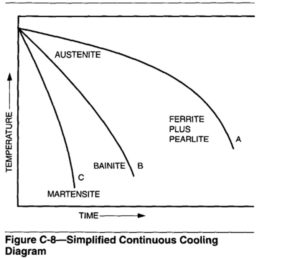diagram similar to the one illustrated in Figure C-8.

With very slow cooling rates (A), a mixture of ferrite and pearlite is likely, and forms at a relatively high temperature. These are the lowest strength steels and are very ductile. At higher cooling rates (B), but lower temperatures, bainite can be formed. Bainite has higher strength and has considerable notch toughness. At still higher rates (C), and the lowest temperature, martensite can be expected. Martensite is very strong but tends to be brittle in the as-quenched condition. In most cases, the martensite is considered to be undesirable because it lacks toughness and because it is prone to hydrogen-induced cracking. By using low-hydrogen welding processes, however, the martensitic welds can provide very high strengths when that property is desired.
